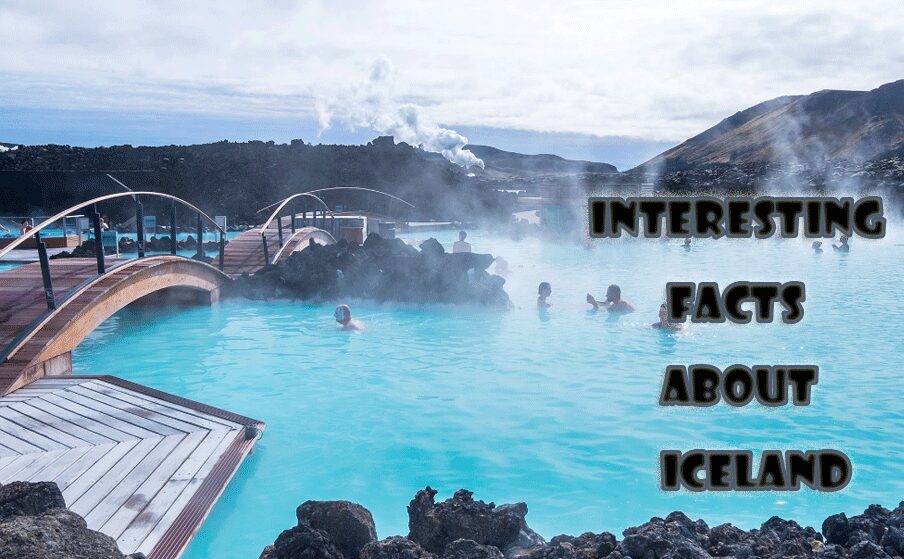Today we will help you out to know about some awesome and interesting facts about Iceland, you will be amazed after reading these facts about Iceland.
30 Interesting facts about Iceland
Country & Nature
- Iceland has about 130 volcanoes. Among them, 18 have erupted since the colonization of Iceland, 1100 years ago.
- Iceland has one of the largest concentrations of geysers in the world. The word “geyser” itself comes from Geysir, the name of a gushing spring in Haukadalur, at the northwestern tip of Iceland. The name of Geysir, in turn, is rooted in the Icelandic word geysa , which means “springing”.
- The Látrabjarg cliffs, which mark the westernmost part of Europe, are the largest bird breeding area in the world. Boasting millions of puffins, gannets, guillemots and little penguins, Látrabjarg is the largest bird cliff in Europe, stretching for 14 km and reaching up to 440 m in height.
- Lakes and glaciers cover 14.3% of the surface of Iceland. Vatnajökull, the largest glacier in the world outside the poles, accounts for 8% of the country’s land area alone.
- Reykjavik is the most northerly capital of all the sovereign states on Earth.
- The small fishing town of Húsavík, on the north coast of Iceland, is the European whale watching capital. Minke whales, humpback whales and blue whales are frequent visitors to the area throughout the spring and summer.
History & Population
- The Althingi, the Parliament of Iceland, is the oldest existing parliamentary institution in the world. It was founded in 930 and was only interrupted for 45 years from 1799 to 1844.
- It has long been considered that the Icelandic people descended exclusively from Norwegian Vikings who settled on the island from 874. Genetic studies have revealed that a significant portion of their ancestry actually goes back to the Celtic populations of Ireland and Sweden. Scotland, who were brought to Iceland as slaves by the Vikings. About 20% of paternal lineages in Iceland are of Gaelic origin (Celtic subgroups of haplogroup R1b , mainly R1b-L21 ). On the maternal side, the proportion is 60% (according to Helgason et al [2001]).
- Icelanders are therefore better defined as ethnically hybrid Celto-Germanic, as are the Lowlanders of Scotland, the English, the Belgians, the South West Germans and the Swiss.
- Iceland was governed by Norway from 1262, then by Denmark from 1380. It did not become an independent republic until 1944.
Society & Culture
- Icelanders watch more movies in the cinema than any other nation, with an average of 5.1 cinema admissions per person per year. This is twice the average in Western Europe, three more than the Germans and five times more than the Japanese!
According to the 2011 Economist Intelligence Index, Iceland enjoys the 2nd highest quality of life in the world. - 65% of Icelandic children are born out of wedlock – the highest rate in the world.
Iceland is said to have the highest number of writers, writers and artists per capita in the world. There is hardly anyone in Iceland who does not write or do art. - Knitting has long been a national obsession of Icelanders, men included.
- raditionally, it was a good way to ensure that you could have warm woolen clothes to wear in winter.
- Icelandic cuisine has dishes that are quite disgusting, such as the súrsaðir hrútspungar (cooked and smoked ram testicles), the hákarl (putrescent shark meat), the lundabaggi (sheep loins smoked in lactic acid) and the svið ( boiled sheep head). Whale and seal meat is also traditionally eaten.
- Despite some rather unattractive traditional specialties, Icelanders do not like to eat ugly animals, like cod. Lobsters, for example, were systematically discarded in the sea before the 1950s.
- Beer was banned throughout the country until 1989. The legal age for alcohol consumption in Iceland is 20 years, the highest in Europe, and alcohol can only be bought in Vínbúð (shops alcohol, which in Iceland are very expensive state monopolies), or in hotels, restaurants and licensed bars.
- The Icelandic government banned prostitution in 2009, strip clubs in 2010 and plans to ban pornography online at the same time, in a bid to eradicate the sex industry.
Same-sex marriage has been legal since 2010 in Iceland. Gay men and lesbians also have the right to adopt children. - One of the most unusual attractions of the country is the Icelandic phallological museum, which houses the largest collection of penises and penis parts in the world. The collection includes 280 samples from 93 species of animals, including 55 whale penins, 36 seals and 118 terrestrial mammals, some of which are believed to be elves and trolls.
Political economics
- In February 2009, Jóhanna Sigurðardóttir became the first female prime minister in Iceland and the first openly lesbian head of government in the world.
- 30% of electricity in Iceland is geothermal – the highest percentage in the world. The rest of the country’s electricity is generated by hydropower, making Iceland the most environmentally friendly country in the world in terms of energy.
- Iceland was until a few years ago (in 2007 and 2008) the country with the highest human development index. The global financial crisis hit the country’s economy hard, and in 2010 Iceland dropped to 17th.
- Iceland ranked first in the global index of peace in 2011 and 2012, out of 158 countries surveyed.
Like other Nordic countries, Iceland has one of the lowest income or wealth inequalities in the world. - 40% of the Icelandic economy depends on the fishing industry and 31% of the production of raw aluminum.
- Iceland is one of the few relatively large countries that does not have a public railway network.












